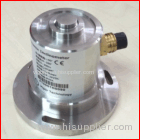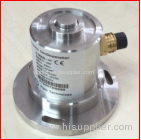The above picture shows a trailing suction hopper dredger working in a river. When this machine works to clean the sludge, it's necessary to monitor the depth of the hopper under the water. And normally, people use a tilt sensor to measure the angle of the suction part to figure out the depth under water. When the tilt sensor measure angle, normally can't get an accurate tilt data of the suction part, and also can't figure out an accurate depth data.
1,The factors which affect the tilt angle measuring of the boat and the suction part.
When the hopper clean sludge under water, the tilt sensor on the arm of the suction hopper can't measure tilt angle accurate, and this caused by the following factors:
1) Boat acceleration or deceleration.
2) Vibration of the engine.
3) Vibration of the suction hopper.
4) Shock when the hopper conflict with something hard.
All the factors can be understood as tri-axis accelerations which bring in bad signals into the tilt sensor sensitivity axis. And the signals can't be filtered easily just by using a low-pass filter.
2,The limitations of the common sensors in market in measuring tilt angle of the suction hopper
The most common tilt sensors in the market are based on the liquid electrolyte capacitor or MEMS solid capacitor principle, both of the two types of sensors measure raw tilt signals with accelerations component in gravity direction to calculate the tilt angle. Both of the two types of sensors are called static inclinometer.
In static condition, the outside forces or accelerations are weak and the sensing element of the sensors sensing tilt signals better than those 'noise', so sensors can measure tilt angle with high accuracy. But in conditions with external forces or acceleration interferences, these two types of sensors will not show good tilt measuring ability.
As for the inclinometer of Liquid condenser principle, there are natural damping effects due to filling with liquid like silicone oil, so it has ability to filter out the middle-high frequencies of vibration accelerations, but the low frequency interference acceleration still cannot filter by sensor itself. And sensor will recognize the low frequency interference accelerations as valid signals and this will cause big tilt angle measurement error.
For the solid capacitor principle tilt sensor based on MEMS technology, there is no liquid or other natural damping media. So it has to uses filters in hardware and software to filter out the interferences accelerations. The effects of final implementation are consistent with the liquid capacitance tilt sensor. Similarly, the tilt sensor of solid-state capacitance principle also cannot withstand the sustained acceleration disturbance.
When the sensors sense the interferences accelerations caused by moving, shaking or vibration, it will lead big tilt angle measurement error. According to the experimental results showing, 1mg interference acceleration in sensor's sensing axis will cause a 0.057degs tilt angle error. If in a condition with constant acceleration or excessive vibration, the interference acceleration can up to 1g, and this will cause a very big tilt angle error, and this error is unacceptable.
3, The new type tilt sensor basing on the concept of quasi-dynamic measurement.
To solve the problem that user can't chose a better sensor to measure tilt angle of the suction hopper with using static inclinometer, VIGOR TECHNOLOGY raised up a new concept of solution, QUASI-DYNAMIC inclinometer. This new type of sensor with the following features:
1) Can be used to measure tilt angle both in static and dynamic;
2) With the excellent features of the static inclinometers in static measuring;
3) With an excellent tilt angle ability in dynamic.
4. The Working Principle of new type tilt sensor.
The internal structure diagram.
The workflow for new quasi-dynamic tilt sensor:
1. When sensor in static (the tilt angular rate less than 3degs/sec), it performs as a normal high accuracy static inclinometer with using acceleration in sensing axis to calculate tilt angle.
2. When sensor in conditions with tilt angular rate bigger than 3degs/sec, the interferences forces/ accelerations will lead big tilt angle measurement error. And at this moment, sensor will calculate tilt angle by using both accelerations (signals from accelerometers) and angular rate (signals from gyroscopes). This kind of algorithm can calculate tilt angle with good accuracy.
3. When sensor at the mounting place with an external shock (any direction in X, Y or Z axis), sensor will perform the angle calculate by using the gyroscopes' signal and this can guarantee that all the signals used in the whole calculation are effective signals.
5,SST55420 is professional Tilt sensor for suction dredges.
According to the suction hopper's actual working conditions and the limitations of the common inclinometers, SST55420 inclinometer can resist short time interference acceleration and prevent the big attitude error and the losing control of the hopper.
In the actual working conditions, the inclinometer installed on the suction hopper will affect by external interference forces/ accelerations, and those external interference forces/accelerations cannot be easy to filter by hardware or software filters. SST54420 inclinometer uses different ways to solve the problem, and it's not just filter out the interference forces/accelerations, but use them as effective signals when measuring. In this way, the SST54420 inclinometer can provide tilt angle value in all working conditions with every value valid and true.
Specifications of SST54420 quasi-dynamic incomplete:
Pitch & Roll | Angle measurement range: pitch, ±30 °; roll, ±15 ° |
Dynamic accuracy: 0.1° (within 10 seconds. 0.02 °/s drift after 10 second) | |
Bandwidth: 0~100Hz | |
Static accuracy: ± 0.01 ° | |
Resolution: 0.005 ° | |
Output data | Raw angular data in X axis |
Raw angular data in Y axis | |
Tilt Angle in X-axis (static + dynamic) | |
Tilt Angle in Y-axis (static + dynamic) | |
Internal sensitivity components | Accelerometer: biaxial, measurement range: ±5g |
Output interface | RS485 |
Refresh rate | 1~50Hz |
Input power | 24VDC±10% |
Power consumption | ≤10W |
Operation temperature | -40~85℃ |
Storage temperature | -40~85℃ |
Shock | 100g@11ms, Tri-axial (half sine) |
Vibration | 8grms, 20~2000Hz |
Protection | IP67 |
Size (initial) | 120×80×60mm |
Weight (estimation) | 300g |






